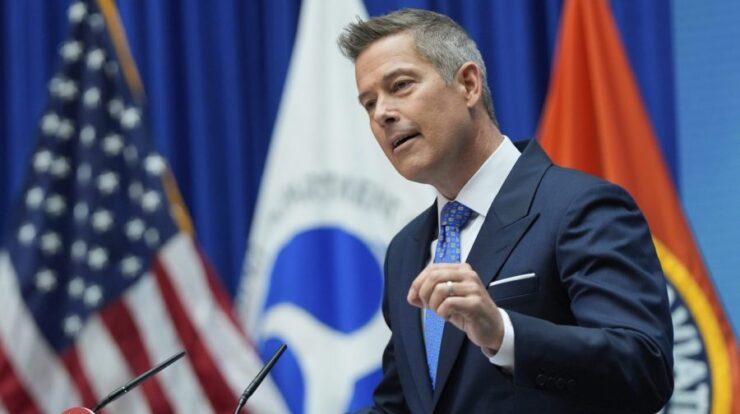
data-document-id=”cms/api/amp/video/AA1EqN0j” data-reference=”video”/>
Transportation Secretary Sean Duffy has urged for a substantial financial commitment totaling billions of dollars towards modernizing the nation’s air traffic control system. This call comes after multiple problems have hindered operations, including recent communication failures at Newark Airport in New Jersey which left numerous flights grounded.
Duffy said at a press conference Thursday that he will ask Congress to grant “upfront appropriations” for all the money needed to update technology and equipment, which he said will be an effort that could take three to four years.
He stated that the department plans to reconstruct certain air traffic control towers and additional facilities, however, “all other systems managing the airspace will be entirely new.”
He mentioned that these improvements encompass advanced telecommunication systems, radios enabling communication between air traffic controllers and aircraft, terrestrial radars, as well as sensors for monitoring taxiways. Additionally, he stated that a sophisticated new flight management system would be established to enhance operational efficiencies within the airspace.
“In essence, all the front-facing equipment for controllers, all the back-end systems for controllers, all brand new,” Duffy said. “All new hardware, all new software, is going to be built into this brand-new air traffic control system.”
He said he can’t accomplish these goals on his own and will need help from Congress. He said he needs funding “up front” because politics and priorities can change over time when funding is only given in smaller, incremental amounts. A cost figure was not mentioned.
A
release from the department
indicates that the strategy encompasses four key infrastructure elements: communication systems, monitoring capabilities, automation processes, and facility structures. Additionally, the announcement highlights several crucial steps outlined in these plans, such as substituting outdated telecommunication equipment with advanced fiber-optic, wireless, and satellite solutions across over 4,600 locations, along with updating 618 radars that have exceeded their operational lifespan.
Additional measures involve constructing six new air traffic control centers for the first time since the 1960s, along with equipping all air traffic facilities with updated hardware and software to guarantee they share a unified platform system.
Duffy said he would appear before Congress every quarter to give an update on the plan’s progress and how much money has been spent.
“They can stress-test what has been implemented for oversight to ensure we’re proceeding correctly,” he stated.
However, Duffy emphasized that allowing reforms is essential to “clear the decks” and ensure that regulations do not impede the proposal’s progress. He pointed out that if regulatory hurdles delay the project, extending the timeline to 10 to 15 years for completion, the technology implemented would become outdated before the project concludes.
Duffy likened the present air traffic control system to an outdated “flip phone” that cannot be expanded upon and requires significant restructuring.
“If we build a new state-of-the-art system, which is what we want to do, then like your iPhone, you can actually get updates,” he said. “You can build on top of what we have in place. So as new technology becomes available, we can actually deploy it. And we’re going to build upon the safety, build on the technology, build on innovation that’s going to happen in this country to continue to make airspace safer and more efficient.”
The announcement comes after chaos disrupted normal operations at Newark Liberty International Airport. Air traffic controllers lost communication with planes at the airport for about 90 seconds last week, which led to
hundreds of flights
being delayed or canceled.
Air traffic controllers at a Philadelphia control center lost radar and communications with the flights, leaving the controllers unable to see, hear or speak to them. The situation escalated, and air traffic controllers took absences through the Federal Employees’ Compensation Act.
The law allows federal workers to take time off if they are injured or experience trauma while working. Some air traffic controllers said they took time off to recover from the stress they experienced from the outages.
Duffy’s suggestion follows multiple incidents at various airports, such as the fatal crash at Reagan Washington National Airport in January, which resulted in 67 fatalities. This accident occurred when a plane struck an Army Black Hawk helicopter engaged in a training exercise.
Duffy was accompanied at the press briefing by the chief executives of the top five airlines and relatives of the individuals who perished in the accident.
More recently, two commercial passenger planes that landed at National Airport last week
needed to shift course
because of an Army helicopter taking a “scenic route” near the airport.
“This is bold. This is going to be challenging, but we absolutely can do it,” he said.
The proposal could face an uphill battle as it comes as the Trump administration and congressional Republicans have been pushing for massive cuts to nondefense spending,
detailed in the budget proposal
the White House released last week. But President Trump called into Duffy’s conference and expressed support for the plan.
Sen. Ted Cruz (R-Texas), chair of the Senate Commerce Committee, was also present at the event Thursday and said he would work to give the department the resources it needs to accomplish the plan.
Updated at 3:28 PM Eastern Daylight Time
Copyright 2025 Nexstar Media, Inc. All rights reserved. This material may not be published, broadcast, rewritten, or redistributed.
For the latest news, weather, sports, and streaming video, head to The Hill.





